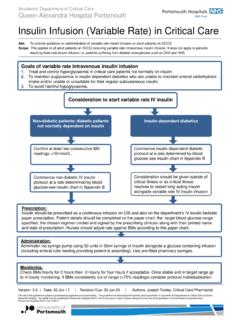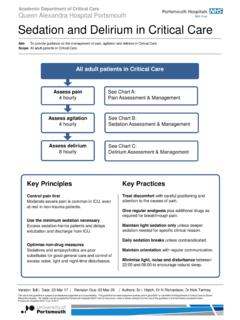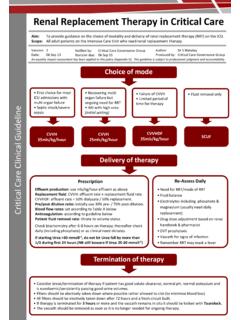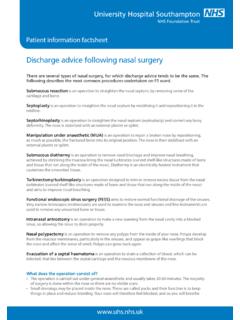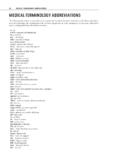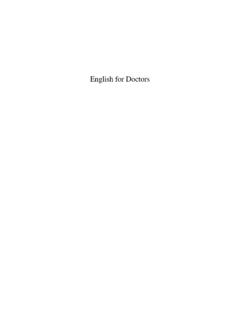Transcription of Nasogastric Tubes in Critical Care - Portsmouth ICU
1 Critical care Clinical Guideline Nasogastric Tubes in Critical care Aim: To provide guidance on insertion, checking and continued care of Nasogastric Tubes (NGTs) in Critical care . Scope: All adult Critical care patients with NGTs. This guideline should not be used outside Critical care . Version: Ratified: 14 Jun 13 (Annex C: 27 Sep 13) An equality impact assessment has been applied to this policy (Appendix B). This guideline is subject to professional judgment and accountability. Ratified by: Critical care Governance Group Revision due: 14 Jun 15 Authors: Dr P McQuillan, Dr N Tarmey Produced by: Critical care Governance Group New NGT Re-positioned NGT Admission with NGT in situ Aspirate NGT Is aspirate more than 10 ml and pH or less? Check Chest X-ray Are all 4 x-ray criteria met? follows oesophagus and avoids contours of bronchi?
2 Clearly bisects carina or bronchi? crosses diaphragm in midline? tip clearly visible below left hemi-diaphragm? YES NO NGT safe to use record details in CIS YES NGT Not Safe to Use Remove or re-position NGT and start again If in doubt, take it out. NO Re-check NGT: every 4 hours during normal use before giving NG drugs if any evidence of displacement (see Box A) Check Length at Nose Is it the same as recorded on insertion? Aspirate NGT Is aspirate more than 10 ml and pH or less? (consider manoeuvres such as turning patient, flushing NGT with air (not fluid), mouth care to encourage secretions, or waiting 15-30 mins) Is there any evidence of displacement? See Box A YES YES NO NO NO YES new hypoxia, possibly aspiration-related unusually severe coughing episode head down postural change (eg CVC insertion) loosened, tampered or dislodged securing method regurgitation or vomiting feed or gastric fluid in airway Box A: Evidence of Displacement includes: Critical care Clinical Guideline Indications and Contraindications to NGT Insertion Indications include: hydration & nutrition enteral drug administration confirming tolerance of enteral feeding gastric decompression Elective surgical admissions do not usually need an NGT Seek senior advice if potential contraindications.
3 Head injury or base of skull fracture maxillofacial surgery (including flaps) oesophageal & gastric surgery recently bleeding oesophageal varices coagulopathy & thrombocytopenia agitation & confusion Insertion Techniques 1. Seek verbal, informed consent if possible. 2. Choose a radio-opaque NGT with numbered depth markings eg Salum Sump Drain for surgical drainage or Corflo size 12 or 14 for feeding in ICU. 3. Estimate distance from patient s nose, to ear, to xiphisternum (NEX length). This is the approximate length needed to reach the stomach (typically 50-60cm). 4. Consider local anaesthetic spray to nose or nasopharynx if patient is conscious. 5. Insert carefully along floor of nose- in posterior & caudal direction, not cranially. 6. Consider sip of water to aid swallowing. 7. Consider a larger NGT or one stiffened by refrigeration if insertion is difficult.
4 8. Consider laryngoscope & Magill s forceps for intubated patients. Increased sedation may be needed. 9. Record the length of the NGT at the naris. an orogastric tube is needed. If so, record the length at the incisors and re-consider changing to an NGT daily. senior experienced help in case of difficulty. 12. Additional guidance is available in the Trust NGT Guideline (available on intranet). Securing NGTs 1. Use red trouser tapes from bridge of nose to NGT. Ensure tape is not bunched, and the NGT hangs free and does not put pressure on naris. 2. Examine skin, mucosa and naris edge pressure areas at least daily and record findings. 3. Tape or adhesive dressing to the cheek can be used instead, but may be less secure. 4. Consider Cavalon to improve tape adherence. 5. Change NGT securing tapes daily.
5 6. If a patient dislodges their NGT repeatedly, consider alternative securing methods including a nasal bridle. 2 Critical care Clinical Guideline Confirming Position, Monitoring & Documentation Competency NGT insertion, aspiration and pH testing may be performed by any competent Critical care staff. Only the following staff may certify correct NGT placement based on a chest x-ray: Radiologists Critical care doctors above FY1 who have completed a DCCQ-approved training package. NGT Aspirates Gastric residual volumes should be recorded 4-hourly to assess absorption & gastric emptying. Free drainage should only be used in case of obstruction or large gastric residual volumes. Documentation Documentation of placement should include: Name & grade of staff inserting & checking NGT Length of NGT at naris Process and any difficulties during insertion Clinical assessment of placement: volume of aspirate pH of aspirate tests confirm acceptable placement (yes/no) If chest x-ray used to assess placement: patient ID confirmed most up-to-date image used criteria for satisfactory placement (see flowchart) x-ray confirms acceptable placement (yes/no) Flushing and Maintaining Patency Do not flush the NGT with anything other than air until position has been confirmed.
6 NGT patency is best maintained with a continuous infusion of NG feed. Where feeds are interrupted (eg for surgery or procedures), the NGT should be flushed with sterile water. When NG feeding is not given, NGTs should be flushed 4 hourly with sterile water after re-confirming acceptable position. NGTs should be flushed with sterile water before and after giving NG medications. NGT Removal and Discharge from Critical care In all patients: The continued need for an NGT should be re-assessed daily. NGTs that are no longer required should be removed without delay. On discharge from Critical care : the presence and rationale for any NGT should be be clearly documented and handed over. consider changing the NGT to the ward-standard 8 French Corflo tube if prolonged use is anticipated. complete DCCQ Temporary Enteral Feeding Regimen form (in discharge pack) 3 Nasogastric Tubes in Critical care Version dated 27 September 2013 4 TABLE OF CONTENTS 1.
7 Introduction 2. Purpose 3. Scope 4. Definitions 5. Duties and Responsibilities 6. Process 7. Training Requirements 8. Monitoring Compliance with, and the Effectiveness of Procedural Documents 9. References and Associated Documents Appendix A. Checklist for the Review and Ratification of Procedural Documents and Consultation and Proposed Implementation Plan Appendix B. Equality Impact Assessment Appendix C. Length Measurement Guide for Salem Sump Tubes Nasogastric Tubes in Critical care Version dated 27 September 2013 5 1. INTRODUCTION This is a local Critical care Guideline which takes into account the special circumstances and difficulties in managing Nasogastric tube (NGT) placement & maintenance in patients in Critical care . This guideline is informed by national recommendations1,3 and Portsmouth Hospitals Trust guidelines,2 with appropriate adaptations for Critical care .
8 Local adaptations are necessary for safe and effective care in Critical care and are supported by the National Patient Safety Agency s Key issues relevant to NGT management in Critical care include: Because of high acuity of Critical care patients, it is not realistic to limit the insertion and checking of NGTs by x-ray to the hours of 08:00 to16:00, as recommended in the Trust NGT guideline. Based on the usual level of staffing and provision of 24-hour care in Critical care , it is appropriate to insert and check NGTs at any time when clinically indicated and suitable staff are present. The majority of patients in Critical care will have an NGT, the reverse of the situation on wards. Gastroparesis is common due to Critical illness itself and the impact of medications (including opiates). Smaller or fine bore Tubes used for feeding are routine in medical and surgical wards but are less reliable for maintaining patency to decompress or empty the stomach.
9 The use of a larger bore or Ryle s tube initially is common Critical care practice, until enteral feeding is established, when fine bore Tubes may be substituted. Drugs used to raise gastric pH are used frequently in Critical care , therefore the use of pH testing to confirm gastric aspirate may be problematic. Because gastric contents in Critical care patients may be less acidic, it is more likely that a genuine gastric aspirate may be rejected on the basis of being too alkaline. Regurgitation, vomiting and changes in posture may cause displacement of NGTs and thus despite correct initial placement, NGTs can later migrate to the airway. These risks may be higher in Critical care patients so a higher level of vigilance must be maintained than in standard ward practice. Frequent chest x-rays are not a realistic confirmatory technique for use at each feeding or drug administration episode, because of radiation exposure and the risks of delays in NGT use and disruption to other essential care .
10 At insertion and at every point of NGT usage (feed or enteral drugs), the nurse or doctor must ask the question am I confident the NGT remains correctly sited and hence safe to use? Concerns and suspicions of the bedside or senior nurse must always be taken seriously and acted upon. Nasogastric Tubes in Critical care Version dated 27 September 2013 6 2. PURPOSE The purpose of this guideline is to provide an evidence-based framework for the use of NGTs in Critical care . 3. SCOPE This guideline applies to all adult patients with an NGT in Critical care . This guideline is for use in Critical care only and is subject to professional judgement and accountability. The ability to comply with this guideline is unlikely to be affected by infection outbreak, flu pandemic or any major incident. 4. DEFINITIONS DCCQ: Department of Critical care , Queen Alexandra Hospital Portsmouth PHT NGT Guideline: PHT clinical Policy for the insertion and maintenance of fine bore Nasogastric feeding Tubes in adults.
